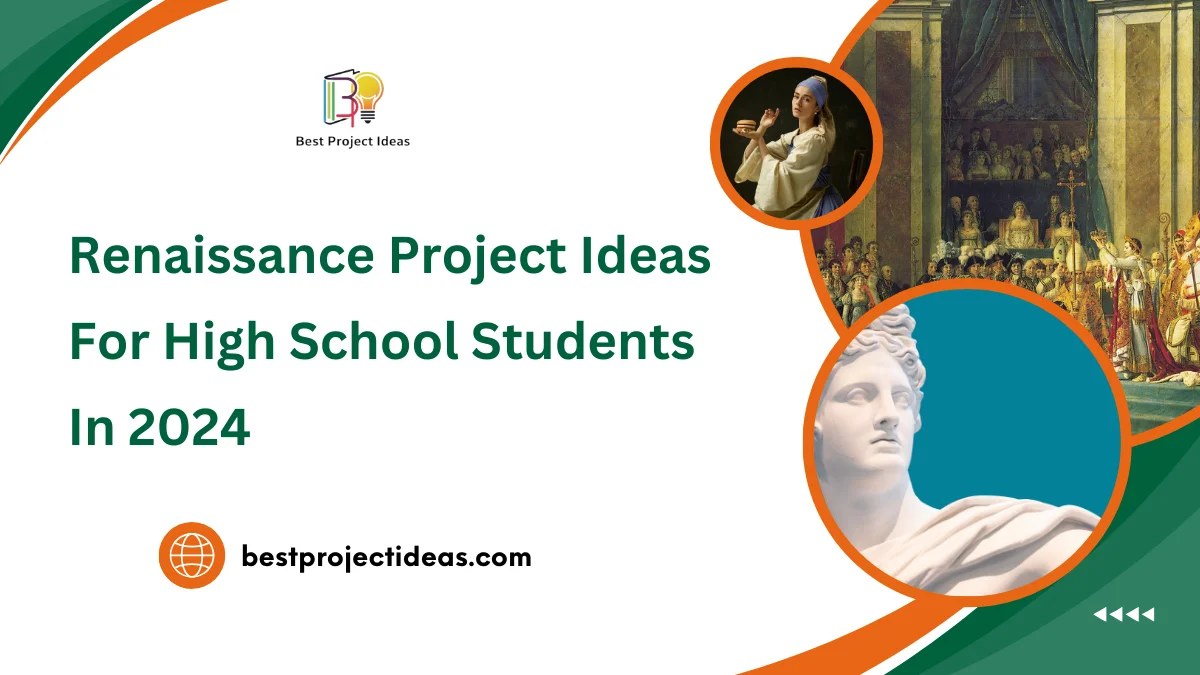
Renaissance project ideas for high school students offer an exciting journey back in time to one of history’s most amazing periods. Students can explore the world of great artists, thinkers, and inventors who changed Europe between the 14th and 17th centuries.
Did you know that Leonardo da Vinci designed a flying machine over 500 years ago? These projects let teens create their own Renaissance-inspired art, build models of famous inventions, or even stage a mini Shakespeare play.
By working on Renaissance projects, students learn about history, art, science, and culture all at once. These fun ideas help bring the past to life and show how the Renaissance still influences our world today.
Why Is Renaissance So Called?
1. The word’s meaning:
“Renaissance” comes from the French word for “rebirth” or “revival.”
2. Time period:
It describes a time in Europe from about 1300 to 1600.
3. What was reborn:
People became interested again in old Greek and Roman ideas about art, writing, and learning.
4. Changes in thinking:
People started to think differently about the world and their place in it.
5. New ideas:
There were many new ideas in art and science, as well as how to study the world.
6. Cultural awakening:
It was like Europe was waking up from a long sleep and seeing things in a new way.
7. Looking back to move forward:
By studying old ideas, people came up with new ones.
8. Spread of knowledge:
The printing press helped spread these new (and old) ideas quickly.
9. Focus on humans:
Art and writing started to focus more on people and their lives.
10. Cultural shift:
It marked a big change from the Middle Ages to the modern world.
So, the Renaissance is called that because it was seen as a rebirth of learning and culture, bringing new life to old ideas and creating many new ones.
Also Read: 21+ New GCP Project Ideas For Beginners (Updated 2025)
What Were The 4 Important Ideals Of The Renaissance?
Here are the 4 essential ideals of the Renaissance:
1. Humanism
This idea puts people at the center of thinking. It said humans are essential and can do great things. Humanists studied old Greek and Roman writings to learn about art, science, and how to live well.
2. Individualism
People started to think more about themselves as special. They believed each person could be unique and essential. This led to more interest in personal achievements and fame.
3. Secularism
While religion was still big, people also began to focus more on worldly things. They became interested in life on Earth, not just heaven. This helped grow art, science, and learning about nature.
4. Classicism
Artists and thinkers looked back to ancient Greek and Roman times for ideas. They tried to copy those old cultures’ balance, beauty, and knowledge. This shaped how they made art, wrote books, and built things.
These ideas changed how people saw the world and themselves. They helped start new ways of thinking that are still important today.
Latest Renaissance Project Ideas For High School Students
1. Build a working model of Leonardo da Vinci’s flying machine
Make a small version of the flying machine Leonardo da Vinci drew in his notebooks. Use wood, cloth, and string to show how it might have worked if it was built back then.
2. Create a Renaissance-style garden
Plan and plant a small garden with herbs and flowers that people grew during the Renaissance. Learn about the plants they used for cooking and medicine.
3. Design a new Renaissance invention
Think of a problem people had in the 1400s or 1500s and draw plans for a machine that could have helped them. Use ideas from real Renaissance inventors to inspire you.
4. Write and perform a short Renaissance play
Make up a story set in Renaissance times. Write it as a play and act it out with your friends. Use simple costumes and props to bring the story to life.
5. Paint a fresco on a wall
Learn how artists painted big pictures on walls during the Renaissance. Try painting a small fresco on a wall or board using similar methods.
6. Make a map of Renaissance Europe
Draw a big map showing Europe’s important cities, trade routes, and landmarks during the Renaissance. Add pictures and facts about each place.
7. Build a model of a Renaissance cathedral
Use cardboard or clay to make a small version of a famous church from the Renaissance. Pay attention to the special features of Renaissance buildings.
8. Create a Renaissance-style costume
Design an outfit that a person might have worn during the Renaissance. Use pictures from old paintings to get ideas for the style and materials.
9. Compose a piece of Renaissance music
Write a short song in the style of Renaissance music. Try using popular instruments back then, like the lute or recorder.
10. Make a Renaissance recipe book
Find old recipes from the Renaissance and put them in a handmade book. Try cooking some dishes and add your notes about how they taste.
11. Design a coat of arms
Create a special shield design for a made-up Renaissance family. Use symbols and colors that show the family’s history and values.
12. Build a working model of Gutenberg’s printing press
Make a miniature version of the machine that helped spread books and ideas during the Renaissance. Show how it changed the way people shared information.
13. Paint a Renaissance-style portrait
Learn how artists painted people during the Renaissance. Try painting a picture of someone you know using similar techniques and styles.
14. Create a Renaissance dance video
Learn some dances that were popular during the Renaissance. Make a video showing the steps and explaining the meaning behind the moves.
15. Design a Renaissance-style building
Draw plans for a house or public building as it might have looked in Renaissance times. Think about how the design shows Renaissance ideas about beauty and balance.
16. Make a model of the solar system
Build a moving model of how Renaissance scientists thought the planets moved around the sun. Compare it to what we know now about space.
17. Write in Renaissance-style calligraphy
Learn how to write beautifully like people did in the Renaissance. Make a poster or book with your best handwriting and decorations.
18. Create a Renaissance-inspired sculpture
Use clay or other materials to make a small statue in the style of Renaissance artists. Try to show the same interest in the human body and nature that they had.
19. Design a Renaissance-style maze garden
Draw plans for a garden maze like the ones rich people had during the Renaissance. Think about how to make it fun and challenging to walk through.
20. Make a model of Leonardo da Vinci’s ideal city
Build a small version of the perfect city Leonardo da Vinci imagined. Use his drawings and ideas about how cities should work to guide your design.
21. Create a Renaissance-style tapestry
Design and make a small wall hanging that tells a story, like the big tapestries from Renaissance times. Use simple materials to show a scene from history or myth.
22. Build a working model of a Renaissance water pump
Make a small version of the machines Renaissance engineers used to move water. Show how it could have helped people in cities or on farms.
23. Design a Renaissance-style board game
Invent a game that people might have played during the Renaissance. Make the board, pieces, and rules using ideas and themes from that time.
24. Create a pop-up book about Renaissance inventions
Make a book with moving parts that show how different Renaissance inventions worked. Include drawings and simple explanations for each one.
25. Build a model of a Renaissance ship
Make a small version of a ship that explorers used during the Renaissance. Show the parts that helped them sail to new places around the world.
26. Design a Renaissance-style coin
Create a fake coin that looks like the money used in Renaissance times. Add pictures and words that show what was important to people back then.
27. Make a Renaissance-style herbal remedy book
Learn about the plants and medicines people used in the Renaissance. Create a book with drawings of the plants and notes on how they were used to help sick people.
How to Choose the Right Renaissance Project?
Here’s how to pick the best Renaissance project for you:
Think about what you like
Choose a project that matches your interests. If you love art, pick something creative. If you’re into science, go for an invention project.
2. Consider your skills
Pick a project that uses your strengths. Good at writing? Try a story or play. Love building things? Go for a model or machine.
3. Look at your resources
Think about what materials you can get. Some projects need special supplies, while others use things you have at home.
4. Check your time
Big projects take more time. If you’re busy, pick something simpler. If you have lots of time, try a bigger challenge.
5. Ask about group work
Find out if you can work with friends. Some projects are fun to do together, while others are better solo.
6. Think about showing your work
How will you present your project? Some ideas work great for displays, others for performances.
7. Connect it to what you’re learning
Try to pick a project that fits with your class topics. It’ll help you understand the Renaissance better.
8. Talk to your teacher
Ask your teacher for advice. They might have good ideas or know what works best for your class.
9. Make it fun
Choose something you’ll enjoy working on. The best projects are ones that excite you.
10. Start simple, then add
Pick a basic idea, then think about how to make it special. You can always add cool extras as you go.
Remember, the best project is one that teaches you something new and lets you have fun learning about the Renaissance!
Challenges And Solutions In Renaissance Project Ideas For High School
Here are some challenges and solutions for Renaissance project ideas in high school:
1. Challenge: Finding accurate information
Students might struggle to find trustworthy sources about the Renaissance.
Solution:
- Use your school library’s history books and databases.
- Ask your teacher for a list of good websites.
- Look for museum websites that focus on Renaissance art and history.
2. Challenge: Making projects interesting
Some students might think Renaissance topics are boring.
Solution:
- Pick a topic you really like, such as art, music, or science.
- Add fun elements to your project, like games or puzzles.
- Use bright colors and eye-catching designs in your work.
3. Challenge: Dealing with old language
Renaissance texts can be hard to understand.
Solution:
- Use modern translations of old texts.
- Ask your teacher to explain tricky words or phrases.
- Make a mini-dictionary of Renaissance terms for your project.
4. Challenge: Creating authentic-looking art or models
Making things look like they’re from the Renaissance can be tough.
Solution:
- Study lots of pictures from that time.
- Use materials that look old, like tea-stained paper.
- Focus on the most important details rather than trying to copy everything.
5. Challenge: Working with limited supplies
You might not have all the materials you need.
Solution:
- Plan your project based on what you can easily get.
- Ask your teacher if the school can provide some supplies.
- Get creative with everyday items to make your project.
6. Challenge: Managing big projects
Some Renaissance projects can be very big and take a lot of time.
Solution:
- Break your project into smaller parts.
- Make a schedule and stick to it.
- Work with a team if your teacher allows it.
7. Challenge: Connecting Renaissance ideas to today
It can be hard to see how the Renaissance matters now.
Solution:
- Look for Renaissance inventions we still use.
- Compare Renaissance art styles to modern ones.
- Show how Renaissance ideas changed the way people think.
8. Challenge: Making projects unique
Many students might pick the same topics.
Solution:
- Choose a less famous Renaissance person or event.
- Combine two different aspects of the Renaissance in your project.
- Present your project in an unusual way, like a video or song.
9. Challenge: Balancing facts and creativity
Projects need to be both correct and interesting.
Solution:
- Start with solid research to get your facts right.
- Then, think of fun ways to share what you learned.
- Ask your teacher to check your work before you finish.
10. Challenge: Fitting everything into the project
There’s so much to learn about the Renaissance, but it’s hard to include it all.
Solution:
- Pick the most critical points for your topic.
- Use pictures or diagrams to show extra information.
- Make a “fun facts” section for interesting but less important details.
By thinking about these challenges and solutions, you can make your Renaissance project both fun and successful.
Final Words
Renaissance project ideas for high school students offer more than just a look into history. These projects help teens build essential skills like creativity, research, and critical thinking. Students learn to see links between art, science, and society, just like the great minds of the Renaissance did.
Teens can improve their writing, public speaking, and teamwork by working on these projects. The Renaissance was a time of big change and discovery; these project ideas captured that spirit of innovation. Whether creating art, exploring inventions, or studying literature, students gain a deeper understanding of how the Renaissance shaped our modern world and continues to inspire us today.

